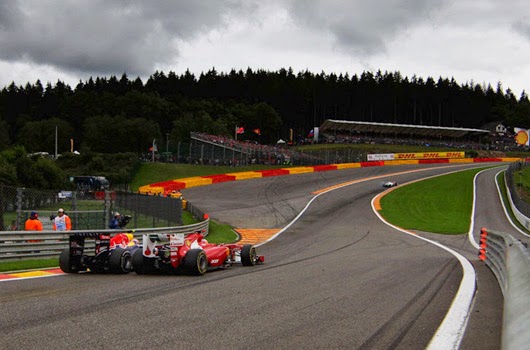Since inception, Spa-Francorchamps has been known for its unpredictable weather. At one stage in its history it had rained at the Belgian Grand Prix for twenty years in a row. Frequently drivers confront a part of the course that is clear and bright while another stretch is rainy and slippery.
The Belgian Grand Prix was designated the European Grand Prix six times between 1925 and 1973, when this title was an honorary designation given each year to one grand prix race in Europe. It is one of the most popular races on the Formula One calendar, due to the scenic and historical Spa-Francorchamps circuit being a favorite of drivers and fans.
Spa Francorchamps has many claims to fame; popularity among drivers, a superb collection of high speed corners, unpredictable weather. But the factor which will probably stand out this weekend is that it is the highest engine power factor circuit on the F1 calendar. The track is 70% full throttle and the run from La Source hairpin to the braking point for Les Combes features 23.5 seconds of constant full throttle. And in this first season of the hybrid turbo power units, that will have a significant bearing on the result.
Add to that the fact that, with only five engines per driver permitted for a season and some drivers already struggling with reliability, we could see some drivers saving engine mileage in Free practice and we could see some blow-ups as engines reach end of life. So engine strategies could be as important as race strategies this weekend.
| TRACK CHARACTERISTICS |
Race Distance : 44 laps (308.052 kilometres).
Corners : 19 corners in total.
Average speed : 238km/h. Circuit based on public roads.
Aerodynamic Setup : Medium to Low downforce.
Top speed : 322km/h (with Drag Reduction System active on rear wing) – 312km/h without.
Full Throttle : 70% of the lap (high).
Time Spent Braking : 14% of lap.
Number Of Brake Zones : 9.
Brake Wear : Low.
| Total Time Needed For Pit Stop : 21 seconds. Lap Record: 1:47.263 (Vettel, Red Bull, 2009) |
| WEATHER FORECAST |
The forecast for this weekend is for cloudy weather, with a chance of rain on Saturday qualifying day.
However this can change very quickly. It’s always a good idea to factor in a wet weather plan. Spa is notorious for fickle weather. With such a long lap, it can be raining on one part of the circuit and the rest can be dry. Also the temperatures can fluctuate dramatically, so it can be 25 degrees one day and 15 degrees the next. This can have a significant effect on the cars.
DRS
Like in previous years, there will be two DRS zones. The detection point for the first zone will be 240m before Turn 2, with the activation point 310m after Turn 4. The second detection point will be 160m before Turn 18, with the activation point 30m after Turn 19.
New debris fences have been installed at Turn 1 of the Spa-Francorchamps circuit ahead of this weekend's Belgian Grand Prix, the FIA has confirmed. In addition, the wall on the driver's left after Turn 11 has been renewed, while drainage has been installed or improved at Turns 2, 4, 8, 11, 16 and 17 – something that is rather critical given rain is a threat over the Spa weekend.
TYRES
Pirelli tyre choice for Spa: Medium and soft. This is the fifth time this season that Pirelli has brought this combination.
It is a more adventurous selection than the last two seasons, where Pirelli brought medium and hard tyres. This reflects a growing confidence on Pirelli’s side after the problems of 2013 with tyre failures. One of the key things for teams to establish in Friday practice is the fastest way to do the race and so getting the maximum preparation time in Free Practice is crucial.
The soft tyre is designed for higher temperatures, so crucial to getting a competitive lap time will be setting the car up so that it switches the tyres on in the all important middle sector.
SAFETY CAR
The chance of a safety car at Spa is statistically high at 80% and 1.4 per race. Rain is one reason, but also accidents tend to be high speed and so there can be quite a lot of debris.
CONCLUSIONS
Qualifying rarely determines the final race result; the pole sitter has only won the race four times in the last 13 years. Overtaking is not a problem at Spa and the DRS wing makes it very straightforward anyway. Throw in a more adventurous tyre selection from Pirelli than in the last couple of years at this track and you have multiple elements that could add up to an exciting race.
It's been a whole month since we've seen any F1 action so Spa is the best place to start off again with all the right ingredients in place.
If you enjoyed this posting, please do share it with your network so more people can enjoy it as well. Also, check out my t-shirt design for Fernando Alonso fans below (designs for other teams and drivers also available), click on image.




1 comment:
great post
Post a Comment